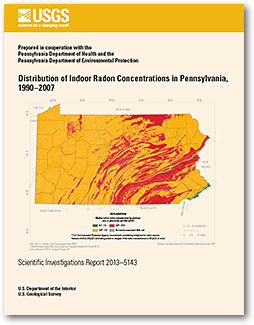 Abstract Abstract
Results from 548,507 indoor radon tests from a database compiled by the Pennsylvania Department of Environmental Protection, Bureau of Radiation Protection, Radon Division, are evaluated in this report in an effort to determine areas where concentrations of radon are highest. Indoor radon concentrations were aggregated according to geologic unit and hydrogeologic setting for spatial analysis. Indoor radon concentrations greater than or equal to the U.S. Environmental Protection Agency (USEPA) action level of 4 picocuries per liter (pCi/L) were observed for 39 percent of the test results; the highest concentration was 1,866.4 pCi/L.
When analyzed according to Pennsylvania’s geologic units, 93 of the 188 (49.5 percent) geologic units with indoor radon concentrations had median concentrations greater than the USEPA action level of 4 pCi/L; most of these geologic units are located in the eastern part of the State and include metamorphic rocks, limestones, sandstones, shales, and glacial deposits. When analyzed according to Pennsylvania’s hydrogeologic settings, 5 of the 20 (25 percent) settings had median indoor radon concentrations greater than the USEPA action level of 4 pCi/L; these settings are located mostly in the south-central part of the State.
Median indoor radon concentrations aggregated according to geologic units and hydrogeologic settings are useful for drawing general conclusions about the occurrence of indoor radon in specific geologic units and hydrogeologic settings, but the associated data and maps have limitations. The aggregated indoor radon data have testing and spatial accuracy limitations due to lack of available information regarding testing conditions and the imprecision of geocoded test locations. In addition, the associated data describing geologic units and hydrogeologic settings have spatial and interpretation accuracy limitations, which are a result of using statewide data to define conditions at test locations and geologic data that represent a broad interpretation of geologic units across the State. As a result, indoor air radon concentration distributions are not proposed for use in predicting individual concentrations at specific sites nor for use as a decision-making tool for property owners to decide whether to test for indoor radon concentrations at specific property locations.
|
First posted September 9, 2013
- PARnGeo ZIP (48.7 MB)
Geospatial data of indoor radon concentrations in Pennsylvania during 1990–2007 and their spatial distribution using the quartiles of measured population distribution according to geologic units.
- PARnHydroGeo ZIP (2 MB)
Geospatial data of indoor radon concentrations in Pennsylvania during 1990–2007 and their spatial distribution using the quartiles of measured population distribution according to hydrogeologic settings.
Part or all of this report is presented in Portable Document Format (PDF); the latest version of Adobe Reader or similar software is required to view it. Download the latest version of Adobe Reader, free of charge. |